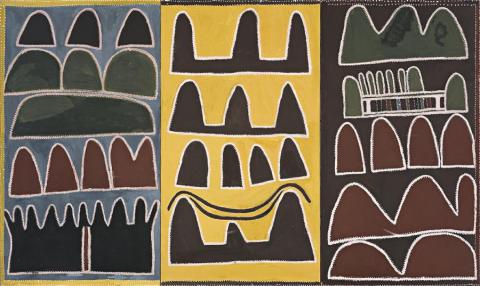TEXAS DOWNS (TRIPTYCH), 1998 (i) BOW RIVER COUNTRY (ii) v (iii) ) MOORNDOO HILLS
Queenie McKenzie Nakarra
natural earth pigments and synthetic binder on canvas
180.5 x 100.5 cm each
180.5 x 301.5 cm overall
each inscribed verso: artist's name, date, size, Red Rock Art cat. KP419A,B,C
Red Rock Art, Kununurra
Private collection, Queensland
Ambitious in scale and conceptual breadth, Texas Downs 1998 is the work of an artist at the height of her powers. In three panels, the work traverses the physical and mythological terrain of Queenie McKenzie's beloved home, Texas Downs Station. Capturing the crowded and rocky topography of the East Kimberley and informed by sacred narratives and complex histories of the region, McKenzie's position as a senior founding figure of the Warmun School of painting is only matched by that of Rover Thomas. As noted by curator Judith Ryan, 'McKenzie was the land she painted. Her work is infused with an indelible cultural power, and comes from her strong connection to Texas Downs country and the ‘true stories' it holds—the traces of spirit essence, of ancestors becoming the land, and stories of dispossession and loss.'1
Depicted here in Texas Downs are three significant sites; Bow River to the east of Warmun community, Yoonoor Country and Morndoo Hills to the south. The topographical formation of Bow River is described in the certificate which accompanies this work as ‘In the dreamtime Ngayiwoorji dog (joolany) ran through the country and was biting a plains Kangaroo (jarlangarnany). The fat dripped out of the kangaroo and formed white rocks which are scattered all through the country.'
Shown in the second panel is Yoornoor Country which is located between Texas Downs and Mistake Creek, itself the site of a massacre of Kija people in 1915. The artist has described its underlying narrative as ‘In (dreamtime) the snake travelled through this country and it became what it is today. She set off from the little ridges; she kept going up and down the little hills looking as she went. She climbed up the hill called Wabngayirriny (shown top left) where she looked back. Then she climbed up Jawoorroogji and Jimarabji (shown in the centre of the painting). When she got to the fourth hill called Darrgayil she camped with her niece Darrgayil and they listened to all the hills she has left behind talking. She said to her niece, ‘You and me won't wait for them', after that she climbed up behind Darrgayil and made a big waterhole called Larrini where she stayed for good (hills at the bottom of the work).'
Moorndoo Hills is home to a particular swimming hole and cave, Wunaba Spring. The area is also significant given it association with the moon dreaming (garnkiny) which relates to a complex series of structures regarding marriage customs. Intense with meaning and history, the three panels combined are a lyrical manifestation of Queenie McKenzie's passion for her country and special affinity for composition and pigment.
1. Ryan, J., ‘Imaging and abstracting country, Queenie McKenzie, Rover Thomas and the Warmun School' in Seear, L,. and Ewington, J., Brought to Light II, Contemporary Australian Art 1966—2006 from the Queensland Art Gallery Collection, Queensland Art Gallery Publishing, Brisbane, 2007, p. 251
MERRYN SCHRIEVER
